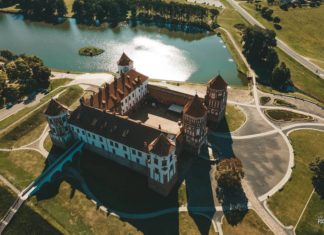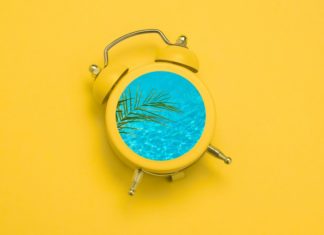Примерно в 20 километрах от Бешенковичей есть агрогородок Бочейково, который будет интересно посетить чтобы увидеть часть наследия рода Цехановецких. Кроме нескольких хозяйственных построек, флигеля и памятного знака можно отыскать место где раньше стоял настоящий дворец с шикарным парком. И что любопытно, сохранились кинокадры с этой усадьбой, снятые для фильма “Джентльмен и петух” (“Пеўні пераклікаюцца”) 1928 года. Благодаря им можно подробнее рассмотреть утраченный дворец и территорию комплекса.

Неплохо известна история Бочейкова, благодаря обширной монографии Владислава Цехановецкого. Так первые сведения о местечке относятся ещё к 15 веку, когда оно принадлежало Юшко Михаловичу Друцкому-Подберескому-Пструцкому, также известному как Ямонтович-Подбереский. После его смерти (умер в 1464 году), Бочейково перешло к последнему полноправному правителю «Мстиславского княжества» – Михалу Ивановичу Мстиславскому-Заславскому. Земель у него было много и к тому же добавилось ещё и богатое приданное жены Юлианны. Однако после развода богатой четы все эти земли разошлись по близким и дальним родственникам, так Бочейково и оказалось у Цехановецких. Что удивительно, этот род оставался владельцем имения с начала 16 века и до подписания Рижского соглашения.

За последующие 400 лет Цехановецкие не раз перестраивали свой фамильный дворец, который в прямом смысле прошел через несколько войн, бедствий, пожаров и разорений. Сохранились письменные воспоминания о том как выглядел фамильный дом образца второй половины 17 века. Так большая усадьба стояла на правом берегу реки, состояла из девяти комнат и придомовой часовни, выступающей в густой сад. По тем временам убранство было впечатляющим.

Рядом с жилым домом Цехоновецких находился флигель несколько меньшего размера, предназначенный для гостей, за ним шла большая кухня и две конюшни на сотню упряжных лошадей. Однако описанная усадьба сгорела в 1708 году, а на её месте впоследствии выстроена более скромная. Вокруг дома был разбит пейзажный парк, вновь построены конюшни, отремонтирован гостевой флигель. Скромность нового имения в Бочейково того периода объясняется тем что Цехановецкие основное время проводили в другом своем имении – Опса.

Кирпичный дворец, который можно увидеть на старых снимках, строился при Юзефе Цехановецком. Есть даже интересная история, что Юзеф затеял это расширение дворца с целью пригласить Станислава Августа Понятовского на охоту. Приехал ли последний король Речи Посполитой или нет, так и неизвестно.

Уже в 1770 году, помимо самого дворца, жилых и хозяйственных построек, в Бочейково располагались многочисленные промышленные предприятия, в том числе крупная суконная фабрика, оружейная, каретная, мебельная фабрика, гончарный и спиртзавод. Чтобы обеспечить себя качественными работниками, местных Цехановецкий отправлял учиться в Париж и Лондон.

Описаний усадьбы того периода сохранилось немного. Упоминается что её проектом занимался малоизвестный итальянский архитектор, который, при строительстве дворца забыл о зимних морозах и не построил ни одной печи. Каминами он оборудовал лишь четыре комнаты. Так что все это пришлось сделать позже.
Во времена Станислава Цехановецкого, во дворце Бочейково, 11 июля 1812 года, на ночь оставался Наполеон Бонапарт. Есть воспоминания, что французского императора встретила полная тишина и пустота, так как большая часть владельцев имения ушла, а все остальные жители скрылись в лесах. В усадьбе остались только управляющий имением Лапицкий, дворецкий и один из его молодых помощников, приписанный к канцелярии. Это настолько удивило Наполеона, что он не преминул выразить Лапицкому свое недовольство.

Вторая половина 19 века для Бочейково было периодом расцвета культуры, сюда часто приезжали видные гости и деятели. Цехановецкие уделяли внимание индустриализации и потому производственная часть не уступала в развитие культурной.

Дворец, построенный Юзефом Цехановецким, представлял собой по сути одноэтажное здание с высокими подвалами и вытянутым прямоугольным планом. Парадный вход выглядел сравнительно скромно, напоминая многие другие классические усадьбы того времени. Фасад выделялся неглубоким портиком на главной оси с двумя тосканскими колоннами квадратного сечения и двумя центральными – с круглым сечением, разделенный по вертикали пилястрами, пронизанный большими прямоугольными оконными проемами, был сплошь покрыт рустом.

Западная сторона в противовес выглядела гораздо живописней. Так как здание построено на склоне, с этой стороны оно было выше, с жилым первым этажом и квадратными окнами. Главный акцент парковой стороны – трехосный, полукруглый эркер от которого шла сложная лестница в сад.


В начале 20 века, Цехановецкие принимают решение перестроить свою фамильную резиденцию. Так у здания появился мансардный этаж и балкон с главного въезда – именно такой облик мы видим в фильме “Джентельмен и петух”.


Благодаря записям Владислава Цехановецкого со всеми инвентаризациями, есть подробные описания внутреннего убранства, картин, предметов интерьера и вещей в доме. К сожалению, теперь всё это лишь списки на бумаге, большинство ценностей было вывезено в Москву ещё до начала Первой мировой войны, а то что оставалось – уничтожили, либо украли.

Последним владельцем имения был – Ежи Станислав Цехановецкий, затем земли национализированы. Судьба усадьбы в Бочейково печальна – от дома не сохранилось и следа, ниже фото того места где стоял шикарный дворец.

До войны здание использовали под различные административные нужды, а в послевоенные годы частично разрушенный дом разбирали местные жители на кирпич. В итоге от имения сохранился “охотничий” флигель, дом для рабочих и несколько хозяйственных построек.

Есть любопытный факт: в Бочейково в 90-ые приезжал один из представителей древнего рода – Анджей Цехановецкий.

Ниже точка с расположением охотничьего флигеля в Бочейково:
Если будете в этих краях рекомендую съездить ещё к одной необычной усадьбе в деревню Пламя.















